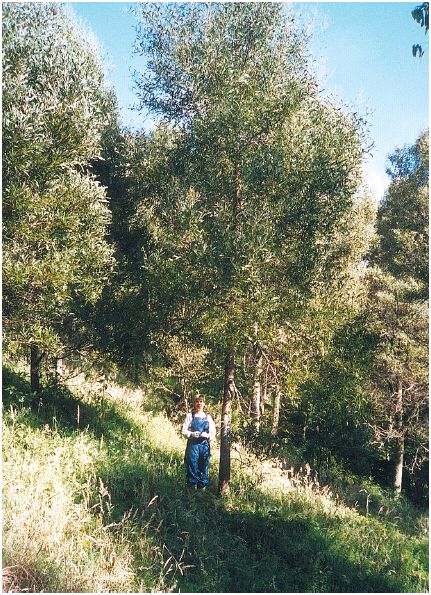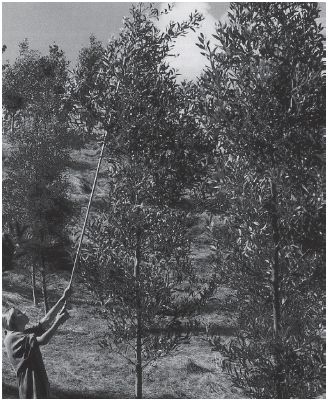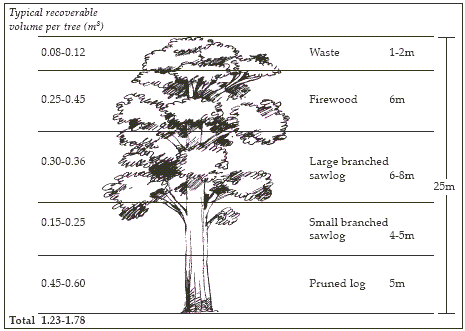Australian blackwood (Acacia melanoxylon)
NZFFA Information leaflet No. 20 (2005).
From the first days of European colonisation the Australian blackwood has had a place among the world’s great decorative timbers. It’s natural range in Australia is extensive, from Tasmania to Queensland – however commercial extraction is largely confined to Tasmania and southern Victoria. Blackwood occupies disturbed sites, growing fromground-stored seeds and sucker shoots. It is commonly associated with eucalypts and occupies gaps among rain forest species. It is a major component of the ‘blackwood swamps’, a series of river flood plains in N.W. Tasmania.
Blackwood has been established in New Zealand for well over 100 years and is now securely naturalised.
More extensive plantings since 1980 followed its recognition by the Forest Research Institute as a species worth special attention for its superb timber qualities. It has the potential to fill a gap once occupied by rimu, is suited to riparian planting, and contributes to diversity in our forest landscapes, but it has had a mixed press, in view of its variable growth rates and commonly poor form. Correct siting and silviculture can resolve both problems.
Establishment

Seedlings can be either bare-rooted or container grown, with little growth difference between them provided they have been correctly grown. The seed source is not critical. Clonal selections are available, and have been trialled (contact Wade Cornell, 247 Forest Hill Rd, Waitakere City 1208, ph (09) 814-9724).
Siting
Blackwood has a capacity to survive across a range of site conditions. However, to produce useful timber it has very specific site requirements – in particular it needs good shelter, and soil moisture during summer growth. It is best suited to the sides of damp gullies and lower valley slopes. It grows poorly on dry exposed sites, in frost pockets, and in stagnant swamps (the “blackwood swamps” are seasonally flooded, but dry underfoot in summer). On good soils, additional fertilisers are not required, but phosphate is advised if soils are deficient. Blackwoods respond to release from weed competition in the first summer.
The form problem
Blackwood has a plastic growth habit, adapting its form to its environment. It produces a straight stem when competing for light, but a short bole with massive branches when open-grown. The primary aim in its silviculture is to produce a straight stem of 5 to 6 metres. This can be achieved by either:
- interplanting with other species
- form pruning
Interplanting
The use of a nurse species which will force the blackwood to compete for light is sound in theory, but difficult in practice; it has resulted in a few successes, and many failures. Basic principles must be followed:
- the nurse should be established before the blackwood is planted, or be much faster growing in the first few years.
- the aim is to impose lateral shading, but allow light from above. This requires periodic visits for branch reduction.
- the method does not eliminate the need for some form pruning.
- the nurse should be considered expendable, and removed when it has served its purpose.
- retaining the nurse as a crop species is unlikely to be successful. The method is best suited to interplanting blackwoods in native scrub (especially manuka and kanuka).
Pruning

There has been an increasing acceptance that pruning is essential in managing blackwood. The method has no resemblance to pruning radiata pine; it is not difficult, but requires a commitment to visit the trees annually during the establishment of the 6 metre stem. There are two stages, which overlap:
- form pruning
- clearwood pruning
Form pruning
Blackwoods have poor apical dominance. Periods of stem growth are interrupted by abortion of the shoot tip. When growth resumes, several shoots compete for leadership. A blackwood stem is therefore formed by segments of straight growth which are interrupted by zones of disturbance which contain double or multiple leaders. The aim of form pruning is to identify and remove these competing leaders while they are still small (< 3cm diameter), and this requires an annual pruning visit during the formation of the 6 metre butt log. Long-handled pruners are useful.
Clearwood pruning
The aim is to confine the defect core. Clearwood pruning is done annually, starting at about year 3, and is complete by about year 8. It is carried out in stages, in which the largest branches on the stem are removed first, using a 3cm calliper. The trunk is then pruned to the diameter of your defect core (10 to 12cm). No more than a third of the foliage is removed at one visit. It is recommended that about 3 metres of the crown is left after each lift. Ladders that grip the trunk should not be used.
A straight pruned butt log of 6 metres is ideal, but any log over 4 metres is acceptable, and slight sinuosity can add character to the grain.
Crown management

This is a neglected aspect of blackwood silviculture. The crown should be even, stable, and live at its base. Three common problems are:
- Small high crown This is caused by delayed thinning, and results in slow diameter growth. Lateral shading is useful during stem development, but the crown should be allowed to expand in open space.
- Asymmetric crown Two crowns in close proximity will interact, causing asymmetry, and produce tensionwood in the trunks. Spacing between final crop trees should therefore be fairly even.
- Unstable crown The problem is breakage in a major fork at the base of the crown. It can be prevented by shortening a competing leader, and by resisting the temptation to prune up to a fork.
Thinning and spacing
This remains under trial, but the best bet currently is to aim for a final crop of 200 trees per hectare, i.e. 7 to 8 metres apart. Plant 800 to 1000 per hectare in rows, or in groups at final spacing, and thin progressively before the crowns interact. On good sites, silvilcultural work is normally completed by 8 to 10 years, and a rotation of about 35 years can be expected.
Photographs reproduced from the February 1997, and February 2002 issues of the New Zealand Tree Grower.
Graphic reproduced from Special Purpose Timber Species – no.1 in the Small Forest Management series, jointly produced by the Ministry of Forestry and the NZ Forest Research Institute. © Crown Copyright Ministry of Forestry, May 1995.
AMIGO
The Acacia Melanoxylon Interest Group is an action group within the Farm Forestry Association, and is the main source of information for blackwood growers. Members include growers, researchers, nurserymen, and commercial users. All blackwood growers who want access to up to date information on silviculture and marketing are strongly encouraged to join. We publish a newsletter twice yearly, and hold a major national field day each year. For membership information contact the NZ Farm Forestry Association National Office, PO Box 10349, the Terrace, Wellington.

 Farm Forestry New Zealand
Farm Forestry New Zealand